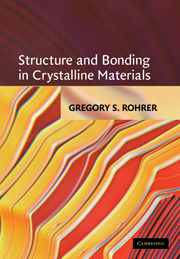Book contents
- Frontmatter
- Contents
- Preface
- 1 Introduction
- 2 Basic Structural Concepts
- 3 Symmetry in Crystal Structures
- 4 Crystal Structures
- 5 Diffraction
- 6 Secondary Bonding
- 7 Ionic Bonding
- 8 Metallic Bonding
- 9 Covalent Bonding
- 10 Models for Predicting Phase Stability and Structure
- Appendix 1A Crystal and univalent radii
- Appendix 2A Computing distances using the metric tensor
- Appendix 2B Computing unit cell volumes
- Appendix 2C Computing interplanar spacings
- Appendix 3A The 230 space groups
- Appendix 3B Selected crystal structure data
- Appendix 5A Introduction to Fourier series
- Appendix 5B Coefficients for atomic scattering factors
- Appendix 7A Evaluation of the Madelung constant
- Appendix 7B Ionic radii for halides and chalcogenides
- Appendix 7C Pauling electronegativities
- Appendix 9A Cohesive energies and band gap data
- Appendix 9B Atomic orbitals and the electronic structure of the atom
- Index
8 - Metallic Bonding
Published online by Cambridge University Press: 23 February 2011
- Frontmatter
- Contents
- Preface
- 1 Introduction
- 2 Basic Structural Concepts
- 3 Symmetry in Crystal Structures
- 4 Crystal Structures
- 5 Diffraction
- 6 Secondary Bonding
- 7 Ionic Bonding
- 8 Metallic Bonding
- 9 Covalent Bonding
- 10 Models for Predicting Phase Stability and Structure
- Appendix 1A Crystal and univalent radii
- Appendix 2A Computing distances using the metric tensor
- Appendix 2B Computing unit cell volumes
- Appendix 2C Computing interplanar spacings
- Appendix 3A The 230 space groups
- Appendix 3B Selected crystal structure data
- Appendix 5A Introduction to Fourier series
- Appendix 5B Coefficients for atomic scattering factors
- Appendix 7A Evaluation of the Madelung constant
- Appendix 7B Ionic radii for halides and chalcogenides
- Appendix 7C Pauling electronegativities
- Appendix 9A Cohesive energies and band gap data
- Appendix 9B Atomic orbitals and the electronic structure of the atom
- Index
Summary
Introduction
When free atoms condense to form a solid, cohesion arises from a change in the occupation and/or distribution of electronic energy levels. In the ionic bonding model, valence electrons move from atomic orbitals on metallic atoms to atomic orbitals on relatively electronegative atoms. Electrostatic cohesion, therefore, results from a change in the occupation of previously existing electronic energy levels on the atoms. In our model for the metallic bond, valence electrons on metallic atoms will be removed from atomic energy levels and placed in crystal energy levels or bands. In this chapter, the band concept is introduced and these new crystal energy levels are described. We begin this chapter with a review of the types of materials that form metallic bonds and a summary of the trends in metallic bond strength.
Materials that are held together by metallic bonds
Figure 8.1 shows a periodic chart in which all of the metallic elements are shaded. The metal–nonmetal definition is the same as that proposed in Chapter 1. Based on this definition, we say that all metallic elements and combinations of metallic elements are bonded metallically.
Phenomenological trends in metallic bonding
The strength of the metallic bond varies with the interatomic separation and the atomic valence. Specifically, the bond strength (as measured by the cohesive energy, Ec, and the melting temperature, Tm) increases as the interatomic separation decreases and as the number of valence electrons increases.
- Type
- Chapter
- Information
- Structure and Bonding in Crystalline Materials , pp. 326 - 362Publisher: Cambridge University PressPrint publication year: 2001



